Programs coming soon...
Programs for 2nd - 5th grade
Description: Programs are designed for elementary students covering topics such as life cycles, adaptations, food chains, and habitats. Each program includes a lecture/discussion, examination of photos, bio-facts and an activity to get students up and moving.
Age Range: 2nd through 5th grade students
Time: Programs are 45 minutes long unless requested to be extended. Program can be extended to 60 minutes in length.
Cost: $0-$115
Where: At your school, community center, or library in Transylvania, Henderson, and Buncombe counties in Western North Carolina.
NC Correlations: Yes, see specific program listings
Materials: We bring photos, life-size animal silhouettes, puppets, and bio-facts (skulls, tracks and scat replicas, fur samples, etc.) to each program for students to touch and manipulate. Also, each program involves a hands-on activity to get students up and moving. We provide teachers with fact sheets about the animals discussed in the program along with ideas for follow-up lessons intended for deeper learning and understanding of the content.
Growing Up
Black Bear
Students will learn about the basic needs and life cycle of North Carolina’s Black Bear. The program includes an activity for students to enhance understanding of how bears live and find food. Students will also use a map to follow the yearly movements of local black bears, learning more about their habitat, diets, and behaviors.
North Carolina Science Essential Standards:
§ 2.L.1.1, 2.L.2.1
§ 4.L.1.1, 4.L.1.2, 4.L.1.3, 4.L.1.4
§ 5.L.2.2, 5.L.2.3
Growing Up
Red Wolf
Students will learn about the basic needs and life cycle of the endangered Red Wolf. Students will take part in an activity to better understand how red wolf pups develop and grow. In the program students will also follow wolf tracks to collect information to complete a red wolf field guide.
North Carolina Science Essential Standards:
§ 2.L.1.1, 2.L.2.1
§ 4.L.1.1, 4.L.1.2, 4.L.1.3, 4.L.1.4
§ 5.L.2.2, 5.L.2.3
Forest Food Web
Students will examine skulls of local forest wildlife and categorize them as herbivore, omnivore, or carnivore and predator or prey based on their teeth, eye placement and other physical structures of the skull. After investigating local wildlife in the forest, students will follow the energy through a forest food web activity to learn more about each animal’s function in the forest ecosystem.
North Carolina Science Essential Standards:
§ 4.L.1.1, 4.L.1.2, 4.L.1.4
§ 5.L.2.2, 5.L.2.3

